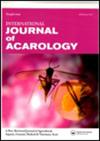Generation-dependent demography and predation capacity of Amblyseius swirskii (Acari: Phytoseiidae) fed on saffron pollen
IF 1
3区 农林科学
Q3 ENTOMOLOGY
引用次数: 2
Abstract
ABSTRACT Using alternative food for mass rearing of phytoseiid predatory mites may facilitate their cost-effective production. Demographic parameters of Amblyseius swirskii Athias-Henriot fed on saffron (Crocus sativus) pollen was determined over 20 continuous generations. Furthermore, the ability of A. swirskii to consume the natural prey Tetranychus urticae Koch after the first, 10th and 20th generations was evaluated. The longest (7.40 d) and shortest (6.18 d) development time occurred in the first and 10th generations, respectively. Females at the 10th generation laid their eggs earlier (after 2.63 days) and also had higher fecundity (49.46 eggs) compared with other generations. The gross reproductive rate (GRR), net reproductive rate (R 0), intrinsic rate of increase (r) and finite rate of increase (λ) of A. swirskii remained stable during different generations. Furthermore, the results of this study revealed that the values of r, GRR and λ were not significantly affected by the generation. The net predation rate (C 0), and finite predation rate (ω) of this predator in 20th generation was significantly higher than the first and 10th generations, which represents high predation capability of the predator after rearing on pollen for a long time. Finally, it can be concluded that saffron pollen maintained a proper performance of A. swirskii up to 20 generations and this alternative diet can be used for mass rearing of this predatory mite.以藏红花花粉为食的SwirskiAmblysius(Acari:Phytoseidae)的世代依赖性种群结构和捕食能力
采用替代饲料大规模饲养植物类捕食性螨可提高其生产成本。以藏红花(Crocus sativus)花粉为食,连续20代测定了其种群统计参数。此外,还评价了褐家鼠在第1代、第10代和第20代后对天然猎物荨麻叶螨的吞噬能力。第1代和第10代发育时间最长(7.40 d),最短(6.18 d)。第10代产卵较早(2.63 d),产卵量也较其他代高(49.46枚)。毛繁殖率(GRR)、净繁殖率(r0)、内在增长率(R)和有限增长率(λ)在不同世代间保持稳定。此外,本研究的结果表明,r、GRR和λ的值不受世代的显著影响。该捕食者第20代的净捕食率(c0)和有限捕食率(ω)显著高于第1代和第10代,说明该捕食者长期以花粉为食,具有较高的捕食能力。结果表明,藏红花花粉在20代内仍能保持良好的繁殖性能,可用于大规模饲养。
本文章由计算机程序翻译,如有差异,请以英文原文为准。
求助全文
约1分钟内获得全文
求助全文
来源期刊
CiteScore
2.20
自引率
9.10%
发文量
60
审稿时长
6-12 weeks
期刊介绍:
The International Journal of Acarology has a global readership and publishes original research and review papers on a wide variety of acarological subjects including:
• mite and tick behavior
• biochemistry
• biology
• control
• ecology
• evolution
• morphology
• physiology
• systematics
• taxonomy (single species descriptions are discouraged unless accompanied by additional new information on ecology, biology, systematics, etc.)
All submitted manuscripts are subject to initial appraisal by the Editor. If the English is not of a quality suitable for reviewers, the manuscript will be returned. If found suitable for further consideration, it will be submitted to peer review by independent, anonymous expert referees. All peer review is single blind.

 求助内容:
求助内容: 应助结果提醒方式:
应助结果提醒方式:


